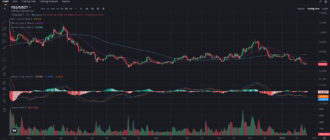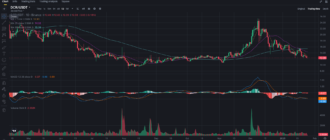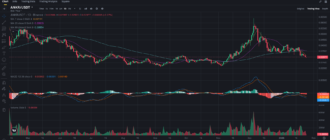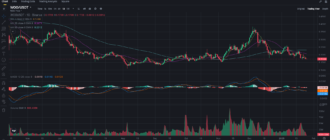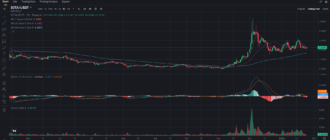SKALE Network (SKL) is a modular Layer-2 scaling solution that enhances the Ethereum ecosystem by offering decentralized, low-latency applications with reduced transaction costs. By enabling developers to build faster and more efficient dApps, SKALE has positioned itself as a promising player in the Layer-2 market. Currently trading at $0.06346, SKL has pulled back after a recent rally to $0.10 in December. In this analysis, we examine SKL’s technical indicators, key support and resistance levels, and price forecast for 2025.
Technical Analysis of SKL’s Price Chart
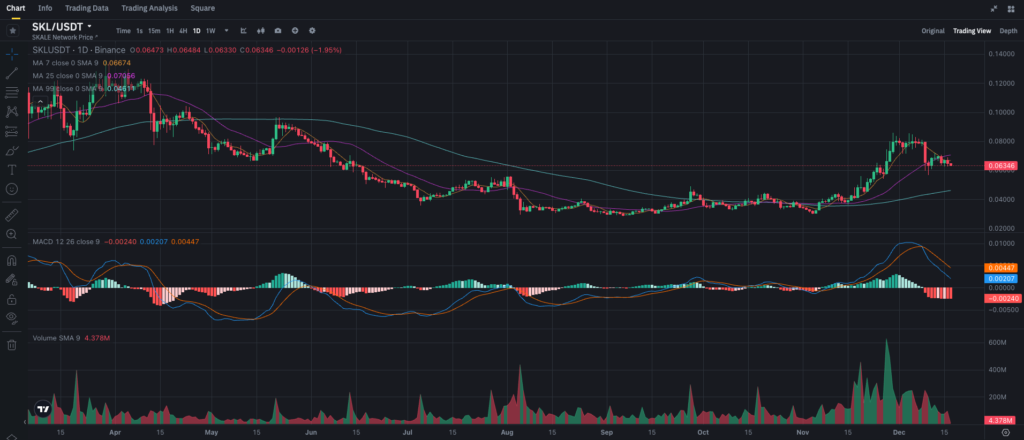
The SKL/USDT daily chart highlights a correction phase following a strong upward surge in November and early December. Let’s break down the critical price zones and indicators:
Support and Resistance Levels
The current price action reveals the following important areas to monitor:
- Support Levels: SKL is hovering near $0.063, its immediate support. If this level fails, the next significant support lies at $0.060, followed by the stronger 99-day MA support at $0.048.
- Resistance Levels: The first resistance is near $0.066, where the 7-day MA sits. Breaking above this level could push SKL toward $0.070–$0.075, a critical mid-term resistance zone. The next major target remains $0.10, its recent high.
Moving Averages (MA)
The moving averages indicate a short-term correction amid a longer-term bullish structure:
- The 7-day MA at $0.0667 is acting as immediate resistance, reflecting short-term bearish sentiment.
- The 25-day MA at $0.07056 reinforces the overhead resistance zone. A breakout above this level would signal a potential reversal toward $0.10.
- The 99-day MA at $0.04811 serves as strong long-term support. As long as SKL holds above this level, the broader uptrend remains intact.
MACD (Moving Average Convergence Divergence)
The MACD indicator shows bearish momentum:
- The MACD line (blue) is below the signal line (orange), confirming a bearish crossover.
- The histogram is in negative territory, suggesting increasing selling pressure.
For a reversal, traders should watch for the MACD line to flatten and eventually cross back above the signal line.
Volume Analysis
Trading volume has decreased significantly compared to the surge seen during SKL’s December rally. This decline indicates reduced buyer activity and suggests a period of consolidation. An increase in volume near support zones, such as $0.060, could signal renewed buying interest.
Price Forecast for 2025
SKL’s future trajectory for 2025 depends on its ability to scale Ethereum-based dApps, attract developer adoption, and capitalize on Layer-2 demand. Below are three scenarios for SKL’s price movement:
Bullish Scenario
If SKL holds above the $0.060 support and breaks through resistance at $0.066–$0.070, it could trigger a recovery toward $0.10. A sustained uptrend, driven by increasing adoption of the SKALE network for decentralized applications, could push SKL toward $0.15–$0.20 by the end of 2025.
Neutral Scenario
In a neutral case, SKL may consolidate between $0.050 and $0.075 for an extended period. This scenario assumes steady adoption without major catalysts to spark strong price movement.
Bearish Scenario
If SKL breaks below $0.060 and fails to hold the 99-day MA support at $0.048, it could decline further to $0.040 or lower. A bearish outcome would likely result from a broader market downturn or reduced developer interest in the SKALE network.
Key Factors That Could Influence SKL’s Price
The performance of the SKALE Network will depend on its role in addressing Ethereum’s scaling challenges. As demand for efficient Layer-2 solutions grows, SKALE’s low fees and scalability could attract more developers, driving demand for SKL tokens.
Network upgrades and integrations with other DeFi projects will play a crucial role. The more dApps and platforms that leverage SKALE for scaling, the greater the utility and adoption of the SKL token.
Competition remains a factor to watch. Layer-2 networks such as Arbitrum, Optimism, and Polygon are all vying for dominance. SKALE will need to differentiate itself through technical innovation and community growth to remain competitive.
The broader market sentiment, particularly the performance of Ethereum and major altcoins, will significantly influence SKL’s price. A bull market could create tailwinds for Layer-2 solutions, while bearish sentiment could limit upside potential.
Possible Actions for Traders and Investors
Short-term traders can monitor support at $0.060 for potential bounces. If SKL reclaims the $0.066–$0.070 zone, traders may target $0.075–$0.10 as profit-taking levels. However, caution is advised if the price breaks below $0.060, as it could signal a deeper correction.
Long-term investors may consider accumulating SKL near key support levels, such as $0.060 and $0.048, with a view toward the project’s long-term potential. As the demand for Layer-2 scaling solutions grows, SKL could see substantial upside by 2025.
Final Thoughts
SKALE Network’s role as an Ethereum scaling solution positions it well for long-term growth in the Layer-2 space. While SKL faces short-term bearish pressure, strong support at $0.060 and the 99-day MA at $0.048 offer a foundation for potential recovery. If SKL reclaims resistance levels and attracts greater developer adoption, it could reach $0.15–$0.20 in 2025 under bullish market conditions. However, broader market trends and competition in the Layer-2 sector will be critical factors to watch.
SKL is available for trading on leading cryptocurrency exchanges, including Binance, Bybit, and HTX.


